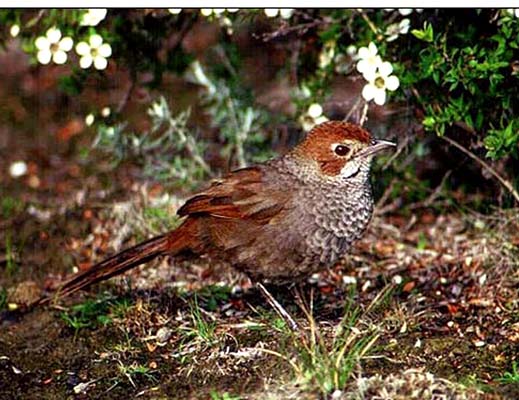 The
Dasyornithidae is a small family of three bristlebirds in the genus
Dasyornis. They are endemic to Australia. All three bristlebirds are
skulkers in thick coastal or montane heath and scrub, and all are generally
similar in appearance. Rufous Bristlebird (left), photographed
by Hans & Judy Beste, has a rusty crown and face and rather
plain wings. Eastern Bristlebird D. brachypterus and Western Bristlebird
D.
longirostris have less colorful head patterns but sport more rusty
wings. The
Dasyornithidae is a small family of three bristlebirds in the genus
Dasyornis. They are endemic to Australia. All three bristlebirds are
skulkers in thick coastal or montane heath and scrub, and all are generally
similar in appearance. Rufous Bristlebird (left), photographed
by Hans & Judy Beste, has a rusty crown and face and rather
plain wings. Eastern Bristlebird D. brachypterus and Western Bristlebird
D.
longirostris have less colorful head patterns but sport more rusty
wings.
Most recent lists (e.g., Sibley & Ahlquist 1990, Sibley & Monroe 1990, Christidis & Boles 1994) placed the three bristlebirds within a broad Pardalotidae that also included the Australasian warblers [Acanthizinae]. Schodde & Mason (1999) explained why the Pardalotidae should be a family, separate from the Acanthizidae (contra Sibley & Monroe 1990). Joel Cracraft, author of the family lists in Dickinson (2003), agreed with this separation and further elevated the bristlebirds [Dasyornithidae] to family status. I presume unpublished genetic data supports this proposal, and some of that data is hinted at in Barker et al. (2004). Apparently the Handbook of the Birds of the World project will not elevate this group as a family, but since I am including all Cracraft/Dickinson families, this is one of those new families. At least for now, it appears that they evolved on separate lineage from all other Australasian groups. |
| Although they are not closely related, the three bristlebirds have
evolved many similarities to the two species of scrub-birds [family Atrichornithidae],
possibly in response to similar habitats. The two groups are rather similar
in size and appearance; both have clear, ringing calls; and both groups
have extremely elusive behavior within the dense, low vegetation that they
frequent. One Australian field guide (Morcombe 2000) places them on the
same page because of these similarities. Further, the range of the Western
Bristlebird is very restricted near the southwest corner of Australia,
just as is the range of the endangered Noisy Scrub-bird Atrichornis
clamosus.
Bristlebirds are hard to observe but can be located and tracked by their distinctive vocalizations, and they are not necessarily shy. If one gets 'inside' the habitat, successful viewing can follow. My Australian friend Murray Lord has seen all three species in car-parks! Of greater concern in the 'big picture' is loss of habitat that has placed all three species at risk. Chapman (1999) summarized: "So specialized have Bristlebirds become that availability of habitat is now a major limiting factor. Even before European settlement they were relicts, restricted to scattered populations in isolated pockets of suitable dense vegetation around the south-eastern and southern coasts of Australia. Both pastoral and coastal development, together with the increased incidence of fire, the advent of foxes and cats, and the general human disturbance have put even greater pressure on the small remaining populations of these shy, essentially groud-dwelling birds." Among the Bristlebirds, Western is the most specialized, restricted to "dwarf, waist-high, windswept coastal heathlands of southern Western Australia" (Chapman 1999). Both Rufous and Eastern uses a slightly broader range of habitats, including rainforest fringes, acacia scrub, lantana and melaleuca thickets, and (for Eastern) a few woodlands that shelter tussock grasslands. Rufous is in some roadside verges but the populations of Eastern are fragmented and often limited to preserved habitat. My only encounter with any species so far was an Eastern in Barren Grounds Nature Reserve, as I walked alone on a rainforest track; this is one of its remaining strongholds (Chapman 1999). Bristlebirds spend most of their life on the ground, preferring to run than fly. "They can run through what appears to be the thickest of vegetation at remarkable speed," writes Chapman (1999). Comparatively little is known about their life history (Frith 1979, Chapman 1999) although it appears they mate for life, live in permanent territories until one of them dies, and share that territory (for at least a period) with their offspring. Their vocalizations are memorable: antiphonal duets between mated pairs being the most impressive of all. |
| Photos: The male Rufous Bristlebird
Dasyornis broadbenti was photographed by Hans & Judy Beste at Apollo
Bay, Victoria, Australia, on 10 Oct 2003. Photos ©
2003 Hans & Judy Beste and used with permission; all rights reserved.
Acknowledgments: Hans & Judy Beste graciously provided the photo. They available to guide independent birders, small groups of birders and wildlife photographers in search of particular species during a visit to Australia, for a reasonable fee; just email them at the link. Murry Lord commented on an ealier version of this page, and suggested improvements; he also provided the Chapman (1999) paper that was useful in writing this page. Bibliographic notes There is no "family book" covering the Dasyornithidae, although good photographs and information about them are found in Frith (1979). They are obviously covered in the Australian field guides (e.g., Simpson & Day 1996, Morcombe 2000 for just two of those). The Handbook of the Birds of the World has not yet reached this group. Literature cited: Barker, F.K., A. Cibois, P. Schikler, J. Feinstein, and J. Cracraft. 2004. Phylogeny and diversification of the largest avian radiation. Proc. Nat. Acad. Sci. 101: 11040-11045. |